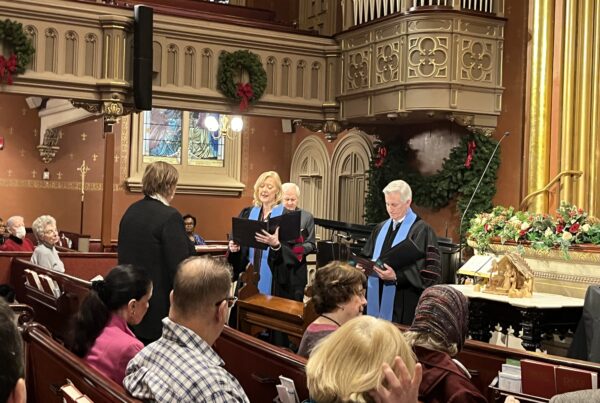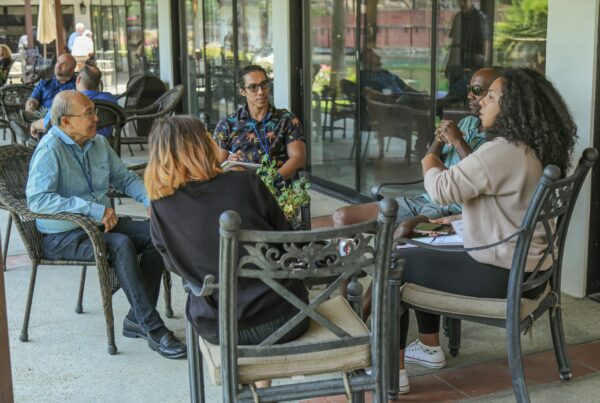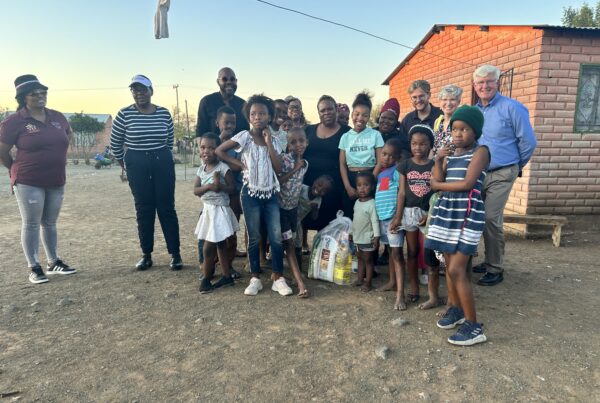It is natural, if we are going to pursue contemplative practices and engage in spiritual practices like centering prayer, to desire some type of theological grounding. We want an anchor. We want to know what these practices are rooted in—and there are many places in the Bible that we can reference in order to provide that grounding.
This material was originally recorded as part of the Renovations Project. It has been lightly edited and condensed for clarity.
Centering prayer helps dismantle the false self
Imagine that we are able to travel back and witness to Jesus’s experience in the wilderness when he’s tempted (Matthew 4:1-11). Pay attention to the language that is used in those temptations. The language sounds like, “If you are who you say you are, the Son of God, then do these things.” In that questioning, if Jesus would have agreed to any of those temptations, then he would have been negotiating the core of who he is. He would have been building up a false identity, a false self.
We can keep this in mind when we think about our experience as followers of Christ. And contemplative practices help us to recognize when those same temptations are coming into play for us.
Let’s say that Jesus would have agreed to the temptations—we can borrow language from Henri Nouwen who helps us to understand how that shows up for us today. Nouwen says that the language of the false self says, “I am what I have. I am what I do. I am what others think or say about me.” In that language, we begin to see the development of our own false selves, the times when we might be handing over the core of who we are and negotiating our identities based on those phrases.
So we have this language from Henri Nouwen, which also correlates with the actual temptations that Jesus faced. There are three temptations.
- The first: if you are who you say you are, then turn this stone to bread—I am what I do.
- The second: if you are who you say you are, then throw yourself off the temple and angels will esteem you—I am what others think or say about me.
- The third: if you would just bow down and worship me, all of this will be yours—I am what I have.
We can see how these things play into identity. They play into temptation. They negotiate the core of who we are. And they also manifest themselves in our daily lives. When we’re talking about contemplative spirituality, it’s very common to see the terms “true self” and “false self.” And today we would refer to this as our “egoic self.”
So taking the temptations of Jesus and taking the language of Henri Nouwen, and then recognizing that we also can over-identify with this egoic part of ourselves, we can rely on the teachings of Father Thomas Keating, who is one of the architects of centering prayer. He really hones in on the over-identification piece in referring to how, when we over-identify, that becomes part of our operating system and our unconscious motivators. He says that our desires for security, power, control, affection, and esteem become things that we become fixated on.
One of the cool things is that contemplative practices go beyond concept to embodiment. We can even take this a level deeper and correlate all of these temptations with an actual place within our bodies. So in order to do that, let’s revisit Nouwen’s language:
- I am what I do. This ties into the turning stone into bread, connecting to our gut or our body.
- I am what others think or say about me. This ties into that affection and esteem place, and that resides in our hearts.
- I am what I have. The desire for control or the just bowing down, and all of this, I would give you. This ties to our minds.
Contemplative practices help us to become aware of the intelligence that lies within our bodies, and begins to help us to dismantle the false self–system, and integrate and embody who we are truly created to be.
Centering prayer moves us toward the Holy Spirit
This material was originally recorded as part of the Renovations Project. It has been lightly edited and condensed for clarity.
The other place that we can go for our theological grounding is Matthew 6:6. This verse says that when you pray, go into your inner room, close the door, and then the Father who sees what is done in secret will reveal things to us in secret. Often, when we first come across this verse, we can interpret it in a very literal sense by creating a sacred space, a sacred room. Some translations say, “Go into your closet and pray.” And praying in our closets is wonderful because we do need sacred spaces for prayer and meditation.
What this verse is also inviting us to do is to remember that the sacred space is within us. So in the ancient world, to have a closet, to have an inner room, would have meant that you were one of the elite. Because this is a teaching of Jesus, it has to be something that is accessible to all. What a centering prayer helps us to do is to enter into that inward experience for ourselves, being moved and motivated by the Spirit.
The intention of centering prayer is to consent to God’s action and presence within. When we’re moving into our inner room, we could simply close our eyes. In some cultures, it would have been represented by an actual prayer cloth or shawl, which would have covered the individual who was going in to pray. This idea of taking time to close ourselves to the outside world and what’s going on and moving towards the divine, the Holy Spirit, that resides within us, helps us to anchor ourselves and also offer some theological grounding when it comes to contemplative practices.

Renew your church’s imagination for ministry
The Renovations Project helps leaders learn, together.
- Thought-provoking masterclasses
- Personalized coaching
- Immersive visit to a ministry innovation hub
- Ministry innovation grants up to $5,000

Tia Norman
Tia Norman is a contemplative leader whose serves as pastor of the Awakenings Movement and curator of the Life Design Academy in Houston, Texas. She is the author of Giving Up Mediocrity: A 40-Day Fast Toward Living a Crazy Fulfilled Life. She participated in listening sessions about innovation hosted by the Reformed Church in America.



